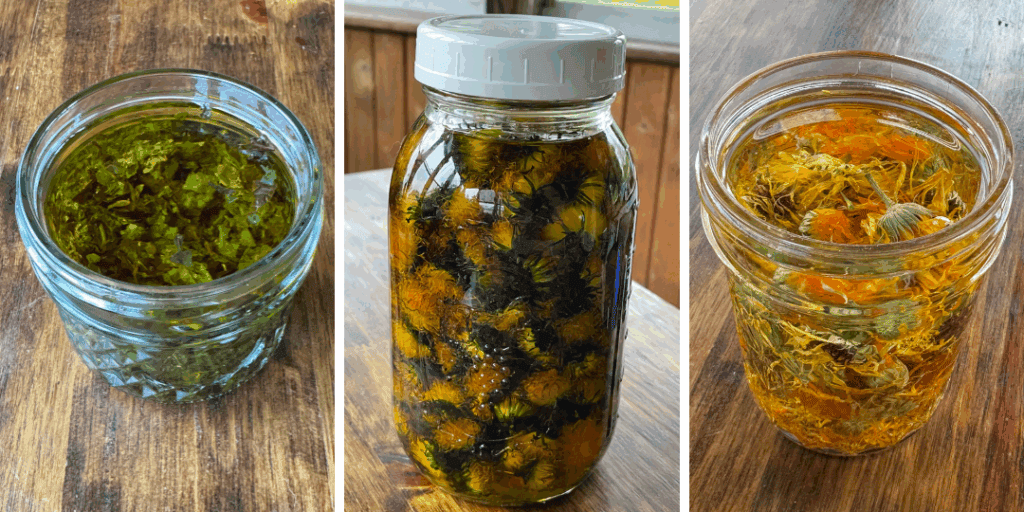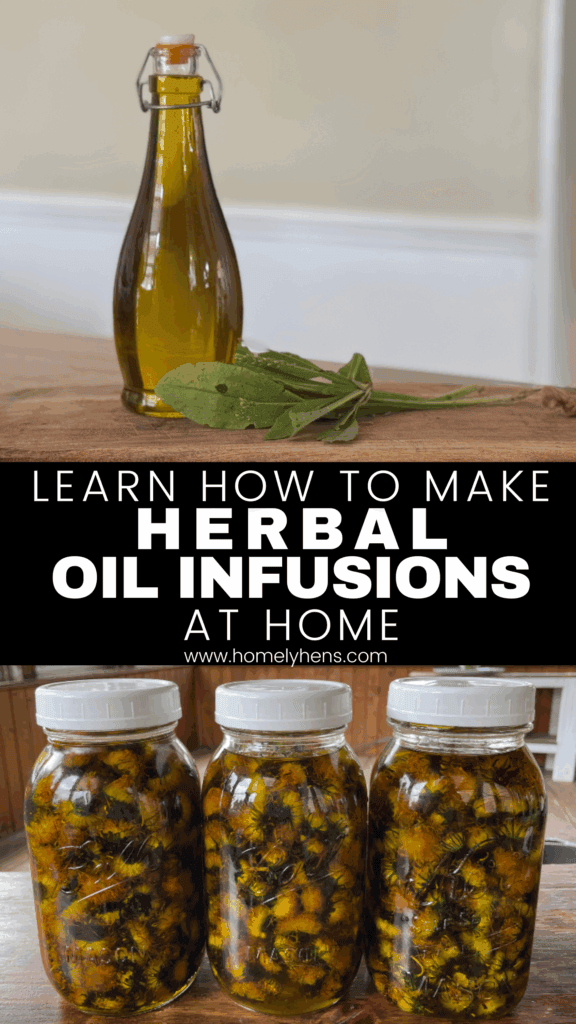How to Make Herbal Infused Oils at Home: Simple DIY Guide
Herbal-infused oils are one of the easiest and most effective ways to bring the healing power of herbs into your everyday routine. Whether you’re soothing dry skin, crafting a homemade salve, or just getting started with natural living, these oils are a homestead essential.
With just a few simple ingredients—dried herbs and a good carrier oil—you can create powerful, multipurpose remedies to use in everything from soap and balms to baby care and massage blends. This page brings together our best how-to guides, favorite recipes, and trusted tools to help you start making herbal oils right from your own kitchen.
This guide is part of our Herbal Remedies and Natural Living series. Explore the full pillar for more DIY recipes, natural care tips, and homestead-friendly herbal solutions.

This post contains affiliate links. This will not cost you anything but will help us offset the cost of running the blog. We only share products we use and would recommend to a friend. Thank you for your support! Click ‘HERE’ for more info.
What are Herbal Infused Oils and Why Make Them?
Herbal-infused oils are powerful tools made from nature’s best oils, herbs, and flowers. Not only are they gentle, yet potent home remedies, but they can also be used for a variety of medicinal and beauty benefits. By making these oils yourself with just a few simple ingredients, you stay in control of both the potency and the ingredients—ensuring you’re using only the highest quality for you and your family.
Additionally, making your own herbal oils is a great way to carry on the wisdom of our ancestors. Herbal oils offer natural ways to treat minor abrasions and skin issues, and they help deliver nutrients deep into the skin. In many cases, herbal-infused oils can be used in place of pharmaceuticals, often with fewer harmful side effects.
Simple Ways to Make Herbal Infused Oils at Home
There are several techniques you can use to make herbal infusions. On one hand, there are slow, more traditional methods; on the other hand, you can try quick infusions when you need your herbal oils right away. In addition, different methods, like blending or crumbling your herbs, or using an alcohol intermediary step, can help make your oils more potent.
Since each flower or herb needs to be treated a little differently, we hope these oil infusion guides will help you with the specific herb you’re working with. Consider what you’re going to use the herbal oil infusion for. Is it for a baby’s sensitive skin, for your face, or used in a soap recipe? These details matter and can change the oil infusion recipe significantly.
- Calendula Infused Coconut Oil – Soothes and softens skin, perfect for babies.
- Lemon Balm Infused Olive Oil – Great for calming blends and cold sores.
- Dandelion-Infused Oil – Eases sore muscles and nourishes the skin.
- Plantain-Infused Oil – Go-to oil for bites, rashes, and a natural first aid.

Best Carrier Oils for Infusing Herbs
There are a lot of natural oils to choose from when you’re going to make infusions. When you’re looking for oil, you generally want to look for organic, cold-pressed, and unrefined. You want the best quality, no chemicals, and fresh ingredients for your natural medicinal and skincare remedies. Here are great oils to choose from and some of their characteristics.
1. Olive Oil
- Benefits: Very stable, long shelf life, moisturizing, affordable, and widely available
- Drawbacks: Slightly greasy, has a strong natural scent
- Best for: All-purpose salves, medicinal herbal oils, and general skin care
2. Sunflower Oil (High Oleic)
- Benefits: Light texture, absorbs well, good solvent properties
- Drawbacks: Regular sunflower oil spoils quickly—use high oleic for better stability
- Best for: Infusions for facial oils, baby products, or quick-absorbing body oils
3. Sweet Almond Oil
- Benefits: Light, nourishing, and gentle on sensitive skin
- Drawbacks: Shorter shelf life (6–12 months), potential allergen for those with nut sensitivities
- Best for: Infusions with calming herbs like calendula or chamomile
4. Grapeseed Oil
- Benefits: Very light and non-greasy, great for oily or acne-prone skin
- Drawbacks: Very short shelf life (3–6 months), oxidizes easily
- Best for: Small-batch infusions that will be used quickly
5. Avocado Oil
- Benefits: Rich in fatty acids and nutrients, deeply moisturizing
- Drawbacks: Heavier feel, shorter shelf life than olive oil
- Best for: Infusions aimed at mature or dry skin (e.g., rose or comfrey)
6. Coconut Oil (Virgin or Refined)
- Benefits: Naturally antibacterial, long shelf life, very stable
- Drawbacks: Solid at room temperature, can clog pores for some skin types
- Best for: Infusions for healing salves, body balms, and foot treatments
7. Apricot Kernel Oil
- Benefits: Light, non-greasy, good for sensitive or baby skin
- Drawbacks: Moderate shelf life (~6 months)
- Best for: Soothing infusions (lavender, chamomile) and baby-safe blends
8. Sesame Oil
- Benefits: Warming, antioxidant-rich, good for massage blends
- Drawbacks: Strong smell, shorter shelf life
- Best for: Warming or pain-relief infusions (ginger, arnica)
Oils to Avoid Using for Infusions
While some of these oils are great for natural skincare use, they aren’t the best to use for infusions and can be added into your recipe in other ways.
- Jojoba Oil- Technically a wax; poor extraction of herbal properties; better added post-infusion.
- Castor Oil- Too thick and sticky for most infusions; difficult to apply. Better as a small % of a blend.
- Flaxseed Oil- Goes rancid extremely fast; unstable even when refrigerated. Not recommended.
- Canola, Soy, Corn Oils- Highly processed, often genetically modified, unstable; avoid in natural skincare.

Favorite Herbs to Infuse and What They’re Good For
There are herbs and flowers in your yard, in the wild, and in your garden that can be dried and used in potent herbal oil infusions. If you can’t find or grow them, some organic herbs and flowers are available to purchase. Here are some popular herbs and flowers that you can infuse.
- Calendula- Anti-inflammatory, skin-healing, excellent for rashes, cuts, and baby products.
- Lavender- Calming, antimicrobial, supports relaxation and skin healing.
- Chamomile- Soothing, anti-inflammatory, great for sensitive skin and eczema.
- Plantain- Wound-healing, draws out toxins, helpful for bites, stings, and minor cuts.
- Comfrey- Promotes cell regeneration and healing of bruises and sprains (use externally only).
- St. John’s Wort- Nerve-soothing, helpful for minor burns, nerve pain, and bruises. Sensitive to sun—store in dark glass.
- Rose Petals- Moisturizing, toning, mildly astringent, supports mature or dry skin.
- Yarrow- Astringent and antimicrobial, great for wounds and oily skin.
- Rosemary- Stimulates circulation, has antimicrobial properties, used in hair and joint oils.
- Thyme- Strong antimicrobial properties, good for respiratory rubs and foot oils.
- Arnica Flowers- Used for bruises, muscle soreness, and joint pain (external use only).
- Dandelion- Anti-inflammatory, relaxing to muscles, useful in massage oils and balms.
- Violet Leaves- Lymphatic support, soothing for inflamed or dry skin.

Recipes Using Infused Oils on the Homestead
After you’ve made your herbal oil infusions, there are so many great uses for them. You can use them as is or make salves, balms, soaps, and more that cater to exactly what your skin needs! Grab your homemade oil infusion and one of our recipes and get started making your own herbal remedy.
- Dandelion Salve – A gentle balm for sore muscles and dry skin.
- Plantain Salve – Natural relief for bites, scrapes, and rashes.
- Calendula Tallow Baby Balm – Nourishes and protects delicate skin.
- Lemon Balm for Cold Sores – Soothing salve to calm flare-ups fast.
How to Store and Use Herbal Oils Safely
Safety in homemade products is always important. Always use clean, sterilized, airtight containers to store your oils, and keep them in a cool, dry place.
Clearly label your infusions with the herbs and oils you used, the infusion date, and the method you followed. Most herbal-infused oils stay good for 6–12 months, but watch for signs of spoilage like a rancid smell, cloudiness or bubbles, and mold (rare, but possible if moisture gets into the oil).
To help keep your herbal oils safe to use, follow these tips:
- Thoroughly strain your oils to remove all plant matter. This helps prevent moisture or mold from contaminating the oil.
- Use clean, dry hands and tools when handling herbs and oils to avoid introducing bacteria.
- For skincare products, always do a patch test to check for irritation.
- For edible oils, make sure you use food-safe ingredients and follow a safe infusion method for consumption.

Tools and Supplies for Infusing Oils
You can keep things simple or go all out when it comes to supplies for infusing oils. Mason jars or repurposed glass containers from your kitchen work just fine for both infusing and storing. But if you’re anything like me, having a few pretty flip-top bottles on hand makes the process even more fun.
You can forage wild plants or grow your own Herbs and Flowers, but if that’s not an option or if something doesn’t grow well in your zone, there are plenty of places to source quality herbs. Just be sure to choose organic whenever possible. Infused oils are concentrated, and the last thing you want is to capture harmful chemicals along with all that goodness.
Here is a list of some of our favorite supplies to help you get started.
- Large Flip Top Bottles – Easy storage that keeps oil fresh.
- Cheesecloth or Fine Mesh Strainer – Strain out the plant material after infusion
- Labels – Label jars so you know exactly what’s in them.
- Organic Vodka – Used as an extra extraction step in some infusions.
- Funnels – Pour accurately using funnels and avoid the mess.
- Scale – Accurate measurements of oils and herbs by weight.
- Measuring Cups and Spoons – Measure by volume with tools.
Explore More Herbal Remedies and Natural Living
Looking to keep going? This page is part of our larger guide to Herbal Remedies and Natural Living. Be sure to explore our other pages (coming soon) on DIY skincare, soap making, salves, and herbal medicine. Each one is filled with step-by-step tutorials, trusted tools, and time-tested remedies to help you build your homestead medicine cabinet naturally.
- Salves and Balms
- Soaps
- Medicinal Herbal Remedies
- DIY Herbal Skincare and Remedies

Frequently Asked Questions About Herbal Oils
Have questions about making or using infused oils? You’re not alone! Below, we answer some of the most common questions about shelf life, safety, and how to choose the right oil and herb combinations for your needs.
Infused oils are made by soaking herbs in a carrier oil over time, while essential oils are distilled and far more concentrated.
Not usually—keep them in a cool, dark place. But if you used fresh herbs, it’s safer to refrigerate them to prevent spoilage.
It depends on the carrier oil, but most last 6–12 months. Be sure to label your jars with dates and check for off smells before use.
If your infusion is food-safe (like garlic in olive oil), yes—but be cautious. For herbal skincare use, always label it “external use only.”
Olive oil, sunflower oil, and jojoba are all gentle and great for sensitive or baby skin.
Ready to Start Making Your Own Herbal Oil?
Whether you’re infusing dandelions for soothing skincare or crafting oil blends for healing salves, working with herbs and oils is a beautiful way to embrace natural living. These simple, time-tested methods connect you to the plants around you and help you care for your family with confidence. Keep exploring, get your jars ready, and see just how easy it is to start building your herbal toolkit—one infusion at a time.



